Covalent bonds Study guides, Class notes & Summaries
Looking for the best study guides, study notes and summaries about Covalent bonds? On this page you'll find 5506 study documents about Covalent bonds.
Page 4 out of 5.506 results
Sort by
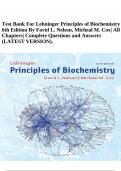
-
Test Bank For Lehninger Principles of Biochemistry 6th Edition By Favid L. Nelson, Micheal M. Cox| All Chapters| Complete Questions and Answers (LATEST VERSION).
- Exam (elaborations) • 273 pages • 2023
- Available in package deal
-
- $24.99
- 1x sold
- + learn more
Test Bank For Lehninger Principles of Biochemistry 6th Edition By Favid L. Nelson, Micheal M. Cox| All Chapters| Complete Questions and Answers (LATEST VERSION). Chapter Chapter 1 1 The Foundations Foundations of of Biochemistry Biochemistry Multiple Choice Questions 1. Cellular foundations Cellular foundations Pages: 33-4 DDiffffiicculttyy: 11 Anns: : CC In a bacterial cell, the DNA is in the: A) cell envelope. B) cell membrane. cell membrane. C) nucleoid. D) nucleus. E) ribosomes. ri...

-
Covalent Bonds questions with correct answers
- Exam (elaborations) • 3 pages • 2023
-
- $11.99
- + learn more
Covalent bonds are formed between CORRECT ANSWER nonmetals Why can a hydrogen atom form a covalent bond without fulfilling the octet rule? CORRECT ANSWER Hydrogen's valence shell can hold only up to two electrons. After a covalent bond has stabilized an atom, the atom will have CORRECT ANSWER a full valence electron shell. What best explains how two oxygen atoms, each with six valence electrons, can bond with each other? CORRECT ANSWER Each atom can share two electrons with the other s...
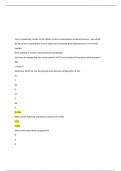
-
CHEM 120 Week 3 Exam 1 (Units 1 & 2)
- Exam (elaborations) • 3 pages • 2023
- Available in package deal
-
- $21.99
- 1x sold
- + learn more
1. You re conducting a study on the effects of carrot consumption on blood pressure. you will be giving carrots to participants in your study and monitoring their blood pressure over several months 2. Which of the following substances contain ionic bonds? 3. What is the name of the compound N 4. Which of the following species would you expect form intermolecular hydrogen bonds? 5. In an experiment you calculate that 6.50 gram of liquid has a volume of 2.50 ml…. What is the mass of a 160 l...
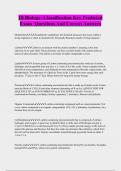
-
IB Biology: Classification Key Predicted Exam Questions And Correct Answers
- Exam (elaborations) • 77 pages • 2024
-
- $10.39
- 1x sold
- + learn more
MetabolismAnabolism+catabolism. the chemical processes that occur within a living organism in order to maintain life. Enzymatic Reactions inside a living organism CarbonCarbon is an element with the atomic number 6, meaning it has four electrons in its outer shell. These electrons can form covalent bonds with carbon atoms or atoms of other elements. This allows a diversity of stable compounds to exist. LipidsA diverse group of Carbon containing macromolecules made up of carbon, hydroge...
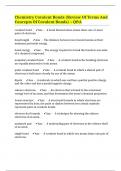
-
Chemistry Covalent Bonds (Review Of Terms And Concepts Of Covalent Bonds) – Q&A
- Exam (elaborations) • 3 pages • 2023
- Available in package deal
-
- $8.49
- + learn more
Chemistry Covalent Bonds (Review Of Terms And Concepts Of Covalent Bonds) – Q&A

-
Biology 1610 FINAL USU 2022/2023 (Questions And A nswers)
- Exam (elaborations) • 73 pages • 2022
-
- $16.49
- 2x sold
- + learn more
The most common isotope of hydrogen has one proton, no neutrons, and one electron. An isotope of hydrogen with 1 neutron would have: an atomic number of 1 and a mass number of 2 In a covalent bond: electrons are shared between atoms so that all atoms have full outer shells A property of a system that is present at one level of organization but absent at the levels below is called: an emergent property An ionic bond is weaker than a covalent bond Modern taxonomy attempts...
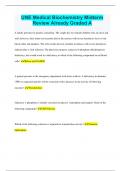
-
UNE Medical Biochemistry Midterm Review Already Graded A
- Exam (elaborations) • 18 pages • 2023
- Available in package deal
-
- $9.99
- 1x sold
- + learn more
UNE Medical Biochemistry Midterm Review Already Graded A A family presents for genetic counseling. The couple has two female children who are alive and well; however, their infant son recently died in the nursery with severe hemolysis (lysis of red blood cells) and jaundice. The wife recalls she lost a brother in infancy with severe hemolysis, induced after a viral infection. The physician suspects a glucose-6-phosphate dehydrogenase deficiency, this would result in a deficiency in which of the...

-
Anatomy and Physiology I Final exam test bank 20222023 (questions and answers) GRADED A UPDATE
- Exam (elaborations) • 25 pages • 2022
-
- $16.49
- 2x sold
- + learn more
Question 1 Correct 1.00 points out of 1.00 Flag question Question text In an ecosystem, energy Select one: a. comes ultimately from bacteria b. cycles along with chemical nutrients c. typically flows from producers through a series of consumers d. typically flows from consumers to producers to decomposers Question 2 Correct 1.00 points out of 1.00 Flag question Question text Life is organized in a hierarchical fashion. Which of the following sequences correctly lists that hierarchy from least in...

-
Covalent Bonds Exam Questions and Answers All Correct
- Exam (elaborations) • 3 pages • 2023
- Available in package deal
-
- $12.99
- + learn more
Covalent Bonds Exam Questions and Answers All Correct Covalent bond - Answer-The chemical bond formed when two atoms share electrons What atoms usually form covalent bonds? - Answer-Nonmetal atoms. Ionic bonds usually form between metal and nonmetal atoms. Describe how nonmetals bond. - Answer-They bond by sharing electrons. Atoms of some nonmetal elements can bond with each other. Two fluorine atoms can react by sharing a pair of electrons. By sharing electrons, each fluorine atom has...
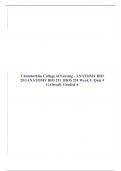
-
Chamberlain College of Nursing - ANATOMY BIO 251/ANATOMY BIO 251_BIOS 251 Week 1: Quiz # 1(Already Graded A
- Exam (elaborations) • 5 pages • 2023
- Available in package deal
-
- $16.00
- 1x sold
- + learn more
BIOS 256 Week 1: Quiz # 1 Question. Which term describes the study of the functions of body structures? (Points : 3) Question. Which feedback system structure receives output from the control center? (Points : 3) Question. Which feedback system structure provides input to the control center? (Points : 3) Question. Which cavity contains the heart? (Points : 3) Question. Which plane divides the body into equal right and left halves? (Points : 3) Question. What are the four major elements found in ...

How much did you already spend on Stuvia? Imagine there are plenty more of you out there paying for study notes, but this time YOU are the seller. Ka-ching! Discover all about earning on Stuvia


